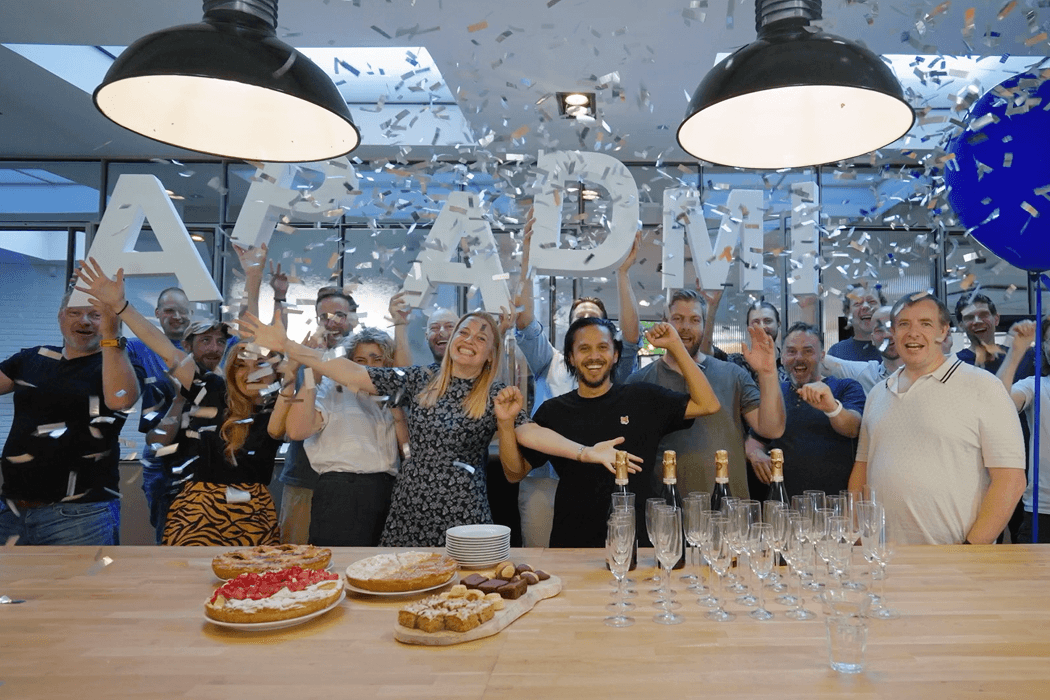Manchester Accessibility Forum at Co-op's Headquarters, Manchester
Date
19/09/2024
Time
05:00 pm
Location
1 Angel Square, Manchester, M60 0AG
About the event
Accessibility is an area that all too often becomes an afterthought when it comes to building digital products. But with the European Accessibility Act 2025 fast approaching, businesses are needing to act fast to ensure their apps and websites will be compliant with new guidelines.
These looming changes aim to improve access to essential digital and electronic facilities for the 135 million people living with disabilities in Europe - including mobile apps.
We gathered a panel of industry experts to share their experiences, insights and advice on how best to embed accessibility into your organisation, people and products to future-proof your digital offerings.
Below is an overview of the insights and learnings from our expert speakers and panellists from some of Europe’s leading brands.

Reframing accessibility as personalisation
Accessibility should not just be about meeting guidelines or regulations—it's about designing experiences that cater to the diverse needs of all users.
Opening the event, Apadmi’s Group Marketing Director Jake Sargent explained how Apadmi often reframes the idea of accessibility as personalisation to clients, to help them see the topic in a different light.
"Accessibility has been after-thought for too long…reframing it as the ultimate form of personalisation can help you get buy-in from the get go.”
“Lots of airtime is being given to personalisation, the more we can know about customers, the more we should be able to personalise an experience to their needs - and ultimately, that is the idea of accessibility, ensuring customers can use products in the way they need”
This idea was also something that Digital Accessibility Manager Ronise Nepomuceno’s shared in her presentation.
“There is a commitment from EE of being the most personal brand and we understand that accessibility is really key to that.”
By framing accessibility in a manner more familiar to people such as personalisation, it can be a more effective way of getting that all important stakeholder engagement to drive forward accessibility initiatives within your organisation.
From compliance to a mission-driven approach
For both speakers and attendees alike, it was clear that accessibility is increasingly becoming a mission-driven approach, something which was largely reflected in Maya Sellon’s presentation.
The Inclusive Design & Digital Accessibility Principal shared how her role evolved from focussing on compliance to becoming mission-driven, and how this has driven forward her work at Shell.
“As I dug deeper I learnt more about WCAG, but I also learnt more about the different models of disability.”
“The medical model of disability sees it as a medical issue that needs to be fixed, the person is disabled. The social model of disability sees it as a social barrier to be removed - it’s the interaction between a person and an external barrier that creates the disability."
For Maya, the job at hand was no longer about compliance, but a mission to remove barriers. It took Maya many years of dedication to shift ways of thinking at her organisation from compliance-based processes to putting accessibility at the core of the company's values and processes The key to her success was gaining executive support and showing that accessibility is a crucial part of a larger equality movement.
"The more I learnt, the more I realised this wasn’t just a standard—it’s a fight for equity in the digital space."
For many in larger organisations, it’s about demonstrating and building awareness that accessibility is not a one-time task but an ongoing commitment. Without executive buy-in and long-term investment, accessibility can unfortunately remain a ‘nice to have’ rather than a ‘must have’, with terrible consequences for disabled users. Having passionate advocates such as Maya within your organisation can help others to foster this more mission-driven approach.
Turning awareness into action and avoiding tick-box mentality
One of the key themes from the event was the growing need to move beyond a tick-box approach to accessibility, and turning that initial awareness into real action.
Dr Elizabeth Blakelock, Accessibility and Inclusion Manager at Monzo reiterated that while legal guidelines like WCAG provide a baseline, they should be seen as the minimum standard. True progress happens when organisations make accessibility a core value, baked into every stage of the product life cycle.
Dr Blakelock also emphasised that while people recognize the importance of accessibility, organisations must actively integrate it into their products and services. It’s about ensuring that users of all abilities can engage with technology without barriers.
"Awareness is high, but it’s time we turned that awareness into action. Let’s remember why we’re doing this—so everyone can access and enjoy the digital world."
"We are so reliant on our phones, and if someone can’t access what they need, when they need it, they’re left behind."
It is about creating innovative experiences that benefit all. A prime example is the touch screen - initially designed to help people with dexterity issues but now a universal feature that we all use daily. Accessibility features can and should benefit everyone, making products more adaptable to various user needs.
Monzo have adapted an approach of listening, learning and leading to ensure that awareness can be turned into real action. Listening to disabled customers and making sure that their voices are at the centre of everything Monzo do is a core value for the business - they also ensure to involve specialists from leading charities to hear more about barriers disabled people may be facing, and how they can help as industry leaders.
"There are small but hugely impactful changes you can make such as allowing users to complete their verification video using British Sign Language, and there are larger changes such as those we've made to our security features - these have come from listening to users."
By investing our time into working with disabled people and including them in the design work we do, we have the chance to develop and radically more accessible and inclusive world
The power of empathy and inclusive design
Lead Designer James Martin stressed the critical role empathy plays in designing for accessibility. As he explained, one in seven people in the UK are neurodivergent, yet society and products are often designed with neurotypical users in mind.
To build better products, designers must take the time to understand different disabilities, how they affect people daily, and how design decisions can either empower or exclude users.
James shared his personal experience as a neurodivergent individual, and how that has shaped his own experiences with products, processes and services in the digital world and beyond. These experiences have driven James to adopt and push the principles of inclusive design at Co-op Insurance.
“It’s about starting with the problem rather than jumping to solutions...focussing on consistency, and making iterative changes can help ensure that products are designed with all users in mind.”
"If we took the time to be more empathic and understand how disabilities affect people daily, we’d build better, more inclusive products."
By implementing these principles, companies can create experiences that are easier to navigate and accessible to everyone, not just a subset of users.
Cross-team collaboration - who should take responsibility?
Accessibility is clearly not just a task for one are of any business —it requires collaboration across multiple departments to succeed. But where should accessibility specialists and experts sit within your organisation?
Digital Accessibility Manager Ronise highlighted how working closely with engineers, designers, and product owners has helped embed accessibility throughout the product development process at EE.
Rather than seeing accessibility as an extra ‘box-ticking’ exercise, EE embraced it as an opportunity for innovation, making their products future-proof by considering accessibility from the very beginning.
Ronise emphasised that accessibility should be a collaborative effort, involving people from all areas of the business. By bringing different teams together, EE has created a culture where accessibility is a core component of their innovation, resulting in more inclusive products that better meet user needs.
"By collaborating across teams, we are making our products future-proof and ensuring accessibility is key to our innovation."
Later on during the panel discussion, BBC’s Andrew Ronksley shared that in their organisation, accessibility often sits with the design team.
“It really starts in research and design for us - sometimes accessibility gets equated only with engineering only and I think that’s wrong, design has a huge role to play”
The panel agreed that wherever accessibility does sit in your organisation, responsibility should not sit solely with one team or be equated with compliance—it needs to permeate the entire organisation. Creating a culture where accessibility is seen as everyone’s responsibility will ensure that companies create digital products that can be used and enjoyed by all.
Leveraging tools to engage key stakeholders
Alongside strategy and collaboration, the right tools can play a crucial role in making digital products accessible and proving a case to key stakeholders.
Apadmi’s Senior User Researcher Lucy Farrington shared how using tools like Fable in her previous role at The Very Group provided access to a panel of users who rely on assistive technology, and how this can be transformative for teams. These tools allow companies to test their products with real users who have disabilities, ensuring that digital experiences are truly accessible.
One of the biggest challenges in accessibility is translating standards like WCAG which can feel abstract to some, into practical, real-world design. With tools like Fable, stakeholders can see first-hand how inaccessible products affect users, which can be a powerful motivator for change. As Lucy noted, seeing how something as simple as an incorrectly labelled button can completely block a user’s experience can shock stakeholders into action
"Being able to show stakeholders how inaccessible products affect disabled users is really profound. Stakeholders are often shocked to see how stuck people can get."
Implementing tools can help bridge the gap between guidelines and real user experiences, making it easier for organisations to understand the importance of accessibility and how to act on it.
Clearly, accessibility is a hot topic across all sectors and businesses as the growing push for digital inclusion gets louder from both inside and outside organisations. Moving forward, it is crucial that accessibility champions across teams talk (or maybe even shout) listen, learn and share to continue making real change and impact in the digital space.
If you would like to find out how you can make your digital product more accessible whether through user research, empathetic design, user-centric development or inclusive strategy, reach out to our mobile experts to see how we can work together to create a more inclusive digital future.
Meet the speakers






Share



